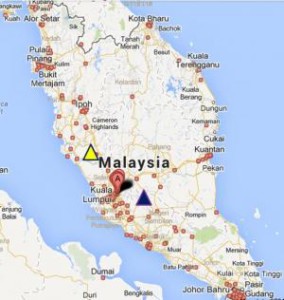The Radio Cosmology Research Group in University of Malaya is the first research group in this country that uses radio astronomy to study the sky at radio wave especially for cosmology since 2005.

Radio telescopes with diameter of 3-meter and 7-meter were constructed in 2009 and 2013, respectively. Bigger telescopes are planned for the future.
There are so much science we have learnt by just looking at the sky. From the formation of the Sun and its planetary system to the idea of gravity and to the snapshot of the early times in the birth of the universe, we are indebted to our ability to scan the sky.
There are, however, much more that we haven’t known about the sky especially when we change the frequency of our vision. In the electromagnetic spectrum and other than the visible light frequency band, only radio wave can penetrate the Earth’s atmosphere and enabling humans to observe the sky at this frequency from ground level. There are already some significant discovery made through this method of radio astronomy such as the Cosmic Microwave Background (CMB) radiation, which is a crucial piece of puzzle in the theory of the origin of the universe called the Big Bang Theory.
Another very important contribution of radio astronomy is the indirect evidence of the mysterious Dark Matter. The study of the rotation of galaxies at radio frequency led to this discovery. Since it does not agree with our usual definition of particle physics, a more accurate understanding of the Dark Matter may lead to the idea and foundation of a new physics. It may well be the next big thing in science after the explosion of excitement that came along with the idea of quantum physics at the turn of the last century.

In the global context, there are already quite a number of research being done in understanding and detecting the Dark Matter through radio astronomy methods. In Malaysia, the researchers at the Radio Cosmology Research Group in University of Malaya have started their research in this aspect since 2005. The head of the group, Associate Professor Dr Zamri Zainal Abidin made a long-term research plan, together with Prof Dr Zainol Abidin Ibrahim and assisted by postdocs, senior researchers as well as postgraduate students. The first part of the plan is to construct a small radio telescope dish of the size of at least 3-meter in diameter. This was successfully carried out in 2009. The second part is the construction of a medium-sized 7.5-meter radio telescope. The main part of this telescope was built in 2013, with the help of another researcher, Mr Wan Zul Adli Wan Mokhtar from the Universiti Pendidikan Sultan Idris (UPSI). This telescope is named the UM-USPI Radio Telescope and will be used as a test instrument in order to build a track record of Dark Matter study and hopefully leading towards more funding to build a much bigger radio telescope which will have a much better resolution for radio astronomy observations. A possible site for this big radio telescope has been identified in Jelebu, Malaysia, where radio interference study and soil investigation have been successfully carried out.
[pullquote]An encouraging early results showed a possible detection of the Neutral Hydrogen— a crucial indirect tracer of Dark Matter, in the galaxy cluster named A262.[/pullquote]
The idea of this project is to use this medium-sized radio telescope to observe the majority part of the clusters of galaxies which are bound together by a common gravitational pull and possibly a common Dark Matter clump. A few test observations were done with the Jodrell Bank Observatory 7-meter radio telescope in Cheshire, United Kingdom. An encouraging early results showed a possible detection of the Neutral Hydrogen in the galaxy cluster named A262. Neutral Hydrogen is a crucial indirect tracer of Dark Matter. The main factor in obtaining a much better accuracy of detection is the total observation time and the only way to overcome this issue is to build our own radio telescope so that we can have easy access to carry out the measurements and other essential experiments. In theory, to obtain a reasonable accuracy in neutral Hydrogen measurement of a galaxy cluster such as A262, 50 days of total integration time is required. Radio telescopes owned by other institutions such as the Jodrell Bank Observatory do not permit such long observation time.

Researchers in the Radio Cosmology Research group, assisted by Professor Dr Hwang Chorng-Yuan, a renowned extragalactic astrophysicist from the National Central University of Taiwan, has been studying the possible candidate of the Dark Matter such as Neutralino. By doing comparisons between simulations, which takes into consideration of the supersymmetry and supergravity models, and measurements of neutral Hydrogen from radio telescope arrays such as the Very Large Array (VLA) in New Mexico, United States, it is found that Neutralino may contribute to a certain percentages of Dark Matter in the galaxy clusters. This results remains to be investigated much further but it is a good start in terms of relating the future experimental results from the UM-UPSI radio telescope (and also the possible big radio telescope in Jelebu) and simulations from accurate parameters that define Dark Matter theoretically.
“The main research grant providers for the group are the High Impact Research Grant (provided by University Malaya and the Ministry of Education of Malaysia’s High Impact Research Grant UM (from 2013 – ongoing), the University of Malaya’s Research Grant (from 2010 to 2011), the Ministry of Education of Malaysia’s FRGS Grant (from 2008 to 2010) and the Ministry of Science, Technology and Innovation of Malaysia’s Science fund (from 2006-2009).”








